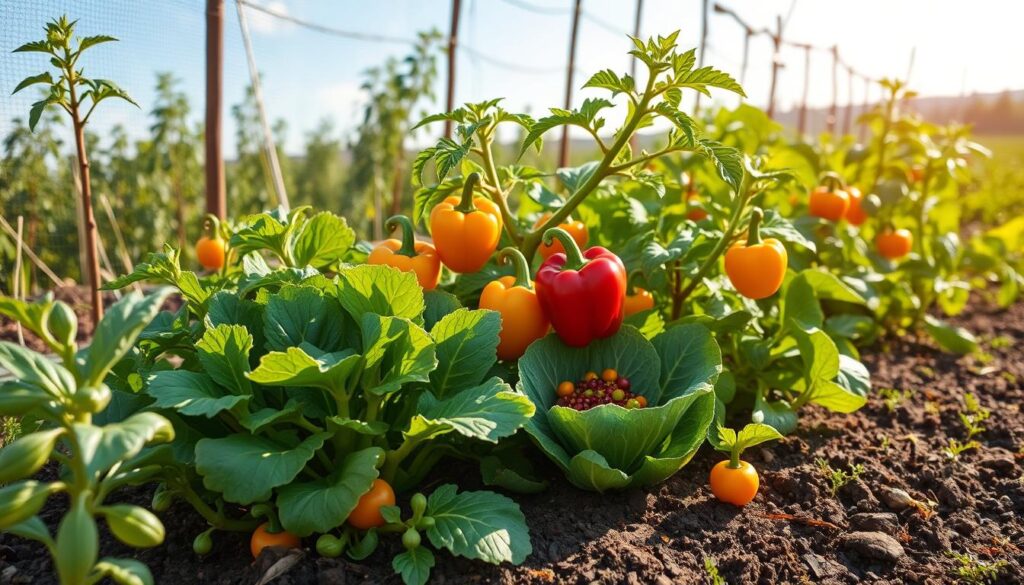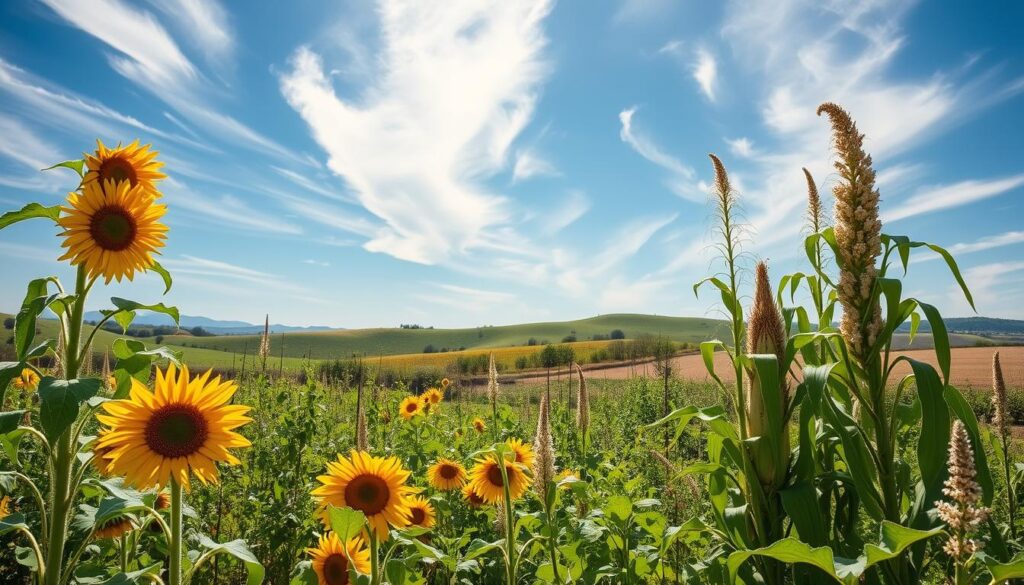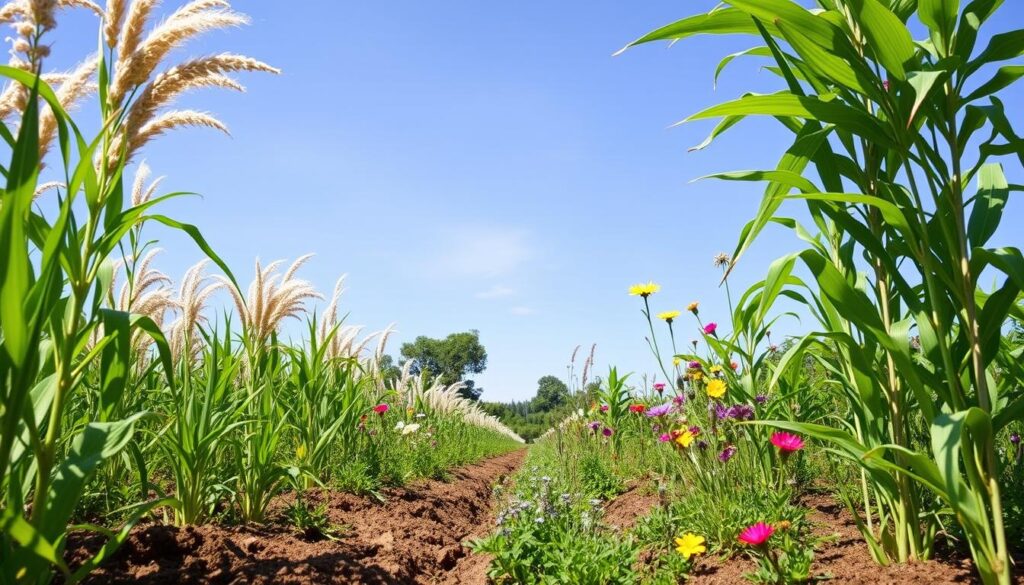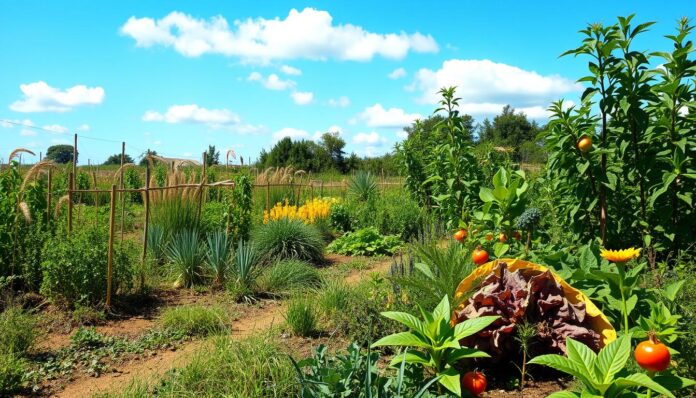Wind can be both a silent destroyer and a powerful ally in farming. As a permaculture enthusiast, I’ve learned that resilient farming is essential. It’s not just a choice, but a survival strategy.
Wind-resistant crops are at the forefront of climate-smart farming. They offer hope to farmers and gardeners in tough environments. These plants thrive where others fail.
It’s important to understand how to adapt crops to different environments. From deserts to temperate zones, the right crops can make all the difference. They can lead to success or failure in farming.
Our exploration of wind-resistant agriculture will cover new techniques and plant choices. We’ll also look at strategies for making tough environments productive. Whether you have a small garden or a large permaculture project, these insights will change how you farm in windy conditions.
Understanding Wind-Resistant Crops
Wind-resistant crops are nature’s way to help farming last longer. These plants have special ways to live in places with lots of wind.
These plants are very strong because of how they grow. They get smaller and have thicker stems and deep roots. This helps them stay strong against bad weather.
“In nature, survival is not about strength, but adaptability” – Wind Ecology Research Team
Drought-tolerant plants are key to farming that lasts. They find ways to keep water in and stay strong in windy weather.
| Crop Characteristic | Wind Adaptation Strategy |
|---|---|
| Root System | Deeper, more extensive network |
| Stem Structure | Flexible yet robust |
| Leaf Design | Smaller, thinner surfaces |
| Water Management | Enhanced conservation mechanisms |
To understand wind-resistant crops, we must see how they survive. It’s not just about picking the right plants. Soil, design, and health matter too.
Studies show that where and how we plant can make crops stronger. More farmers and gardeners are choosing plants that can handle wind.
Challenges of High Wind Areas
Wind is a big stress for farms. It affects how plants grow and produce. Farmers and gardeners in windy areas face big challenges.
Dealing with wind is key to fighting climate change. Wind can make plants stressed and hurt their growth. Plants in windy areas grow differently to protect themselves.
The resilience of agricultural systems depends on understanding intricate wind-plant interactions and implementing agroecological approaches.
Here are some wind-related problems for farms:
| Wind Challenge | Agricultural Impact |
|---|---|
| Water Loss | Increased evaporation reduces plant hydration |
| Soil Erosion | Reduces soil fertility and nutrient retention |
| Physical Damage | Breaks stems, damages leaves, disrupts growth |
| Pollination Interference | Reduces successful plant reproduction |
Studying plants as whole systems is crucial. Experts suggest using native plants and new farming methods to fight wind problems.
Characteristics of Wind-Resistant Crops
Plant breeding has changed how we grow crops in tough places. Wind-resistant crops have special traits to handle harsh winds. These plants grow well even in bad weather.
“Nature’s resilience is best observed in plants that can withstand the most challenging environmental conditions.”
Wind-resistant plants have key features. Their stems are flexible, so they can bend in strong winds without breaking. Drought-resistant plants also have these traits to survive extreme weather.
Some important physical traits include:
- Small or narrow leaves to reduce wind resistance
- Deep and expansive root systems
- Ability to minimize water loss
| Adaptation Type | Characteristics | Examples |
|---|---|---|
| Stem Flexibility | Ability to bend without breaking | Ornamental grasses, palms |
| Leaf Structure | Narrow or small leaf surfaces | Needle-leaved conifers |
| Root Development | Strong, deep root systems | American holly, basswood |
Knowing these traits helps farmers and gardeners pick the right crops for windy areas. Plant breeding keeps improving crops to grow well in tough conditions.
Popular Wind-Resistant Vegetables

For gardeners in windy areas, using resilient practices is key. Some vegetables are especially good at handling strong winds. This makes sure gardens can thrive even in tough weather.
Kale is a top choice for windy gardens. ‘Lacinato’ and ‘Curly Kale’ are great because they can handle strong winds well. Their strong stems and tight growth keep them stable in gusts.
| Vegetable Type | Recommended Variety | Wind Resistance Rating |
|---|---|---|
| Kale | Lacinato | Excellent |
| Carrots | Nantes | Very Good |
| Radish | Cherry Belle | Good |
| Spinach | Bloomsdale | Very Good |
Root vegetables are also great for windy gardens. Carrots like ‘Nantes’ and ‘Danvers’ do well in tough weather. Their deep roots keep them grounded and safe from wind damage.
“In sustainable agriculture, selecting the right vegetable varieties can mean the difference between crop failure and success.” – Agricultural Resilience Institute
Radishes, especially ‘Cherry Belle’ and ‘French Breakfast’, are good choices for windy areas. They grow fast and adapt well to harsh conditions. This makes them perfect for permaculture in windy spots.
Wind-Resistant Grains for Sustainability
Climate-smart farming is changing how we grow food, with a focus on wind-resistant grains. Kernza, a wild grass developed by The Land Institute, is leading the way. It’s a perennial grain that shows great promise for tough farming conditions.
These grains are key for sustainable farming. They can handle harsh weather and help keep soil healthy. Barley, rye, and some wheat types are especially good at this.
“Diversity in our grain systems is key to building resilient agricultural landscapes.” – Agricultural Sustainability Expert
Grain farming faces big challenges. It’s a big source of greenhouse gases, and soil erosion is a big problem. Wind-resistant grains are a smart way to tackle these issues.
| Grain Type | Wind Resistance | Sustainability Factor |
|---|---|---|
| Kernza | High | Perennial, Low Erosion |
| Rye | Moderate | Drought Tolerant |
| Barley | High | Low Water Requirement |
Creating these grains takes a lot of time and research. Farmers and scientists are working hard to breed crops that can handle changing weather. They focus on genetic diversity and how well crops adapt.
Choosing the Right Location
Finding the best spot is key for growing crops in windy areas. Wind can harm crops, so picking the right place is important. It helps fight climate change too.
When picking a spot for crops, farmers need to think about a few things. Natural barriers like trees help protect plants from wind. Trees like sugar maple and oak can block some wind while still letting air through.
“The right location can mean the difference between crop success and failure in challenging wind environments.” – Agricultural Research Expert
There are special spots in a landscape that are better for growing crops in windy areas. Slopes and trees can offer natural protection. Knowing these spots helps farmers grow crops better and reduce wind damage.
| Windbreak Characteristic | Recommended Approach |
|---|---|
| Windbreak Density | 25-65% porosity for optimal wind reduction |
| Shrub Spacing | 3-6 feet within rows, 6-10 feet between rows |
| Tree Spacing | 12-20 feet within rows, 20 feet between rows |
Planting wind-resistant plants like succulents can also help. These plants can handle strong winds well. They make great neighbors for crops in windy places.
By choosing the right spot, farmers can grow crops that are more resilient. This helps them adapt to changing weather and grow food in a sustainable way.
Natural Windbreaks and Their Role
Natural windbreaks are key in agroecological methods. They protect crops and make farms more resilient. These barriers, made of trees and shrubs, do more than block wind. They slow down wind by 70-80%, helping crops grow better and keeping soil healthy.
Where you plant windbreaks matters a lot. Experts say to place them 2 to 5 times the height of the trees away. Trees facing north and northwest are best. They block harsh winds and protect crops.
“Windbreaks are not just barriers—they are living ecosystems that enhance agricultural resilience.” – Sustainable Farming Research Institute
Windbreaks do more than just block wind. They also help wildlife, stop soil erosion, and keep temperatures steady. Field windbreaks, with 1-3 rows of plants, protect soil up to 10 times the tree’s height. This can even make crops grow more.
| Windbreak Characteristic | Impact on Agriculture |
|---|---|
| Wind Speed Reduction | 70-80% immediate reduction |
| Crop Protection Range | Up to 10 times tree height |
| Wildlife Support | Increased habitat diversity |
Setting up windbreaks needs careful planning. Plants should be 4 feet apart in rows and 6 feet between rows. Keeping seedlings safe from other plants is key to a successful windbreak in agroecological farming.
Companion Planting for Wind Resistance

Resilient farming uses smart planting to guard crops from wind. By picking the right plants, farmers can make natural barriers. These barriers protect plants from harsh winds.
Marigolds and African daisies are great for windy gardens. Permaculture shows they can handle strong winds and shield veggies. Their strong roots and small size help keep soil in place and prevent damage.
“In nature, diversity is strength. Companion planting mimics ecological systems, creating resilient agricultural landscapes.” – Permaculture Design Principle
Using herbs like artemisia with veggies is smart. Purslane is a good ground cover that stops soil from washing away. Zinnias and coreopsis can be used to make wind barriers that help plants grow better.
| Plant Type | Wind Resistance Level | Growing Zones |
|---|---|---|
| Marigolds | High | 2-11 |
| Purslane | Extremely High | All Zones |
| African Daisies | High | 9-11 |
Creating a wind-resistant garden needs planning and knowing your area’s weather. Watch the wind, choose the right plants, and layer them for growth and safety.
Innovative Agricultural Techniques
Plant breeding innovations are changing how we farm in tough weather. Farmers use new tech to grow crops that can handle extreme weather. Climate-smart farming is making farming more resilient.
Genetic tech like CRISPR lets us make crops better. We can now grow varieties that fight off drought, pests, and harsh weather. Silicon-enhanced crops are also showing great promise, making plants 20% more resilient.
“Innovation is the key to agricultural adaptation in a changing climate.” – Agricultural Research Expert
Precision agriculture is key in modern farming. GPS and sensors help farmers use resources better. This can boost yields by 15-30%, making farming more productive.
| Innovation Type | Potential Impact |
|---|---|
| Gene Editing | Develop pest-resistant crops |
| Precision Agriculture | 15-30% yield improvement |
| AI Technologies | Enhanced crop monitoring |
Climate-smart farming is more than just tech. It’s a smart way to farm sustainably. By using new methods, farmers can make farming systems that can handle changing weather.
Alluring Perennials for Windy Environments
Perennial plants are great for gardens in windy areas. They grow deep roots that hold them in place. This makes them perfect for permaculture designs.
Drought-tolerant plants are key in building strong gardens. Sea buckthorn, Rosa rugosa, and hardy geraniums are great examples. They handle strong winds well.
“In wind-exposed environments, the right perennial can transform vulnerability into strength.” – Permaculture Design Expert
Choosing the right perennials for windy spots is important. Look for plants with narrow leaves, waxy surfaces, and flexible stems. These plants do well in harsh winds.
| Perennial Type | Wind Tolerance | Drought Resistance | Root System |
|—————|—————-|——————-|————-|
| Sea Buckthorn | High | Excellent | Deep, Spreading |
| Rosa Rugosa | Very High | Good | Extensive |
| Hardy Geraniums | Moderate | Good | Moderate Depth |
| Rosemary | High | Excellent | Shallow, Dense |
| Achillea | High | Very Good | Fibrous |
By using these perennials, gardeners can make landscapes that last. Wind-resistant plants help gardens survive tough conditions.
When picking plants, think about your local climate, soil, and wind. Plants like delosperma and Stipa tenuissima add beauty and protection.
Seasonal Wind-Resistant Gardening Tips
To make a wind-resistant garden, plan all year round. It’s important to think about the seasons and how they affect your garden. In areas with lots of wind, it’s key to protect your plants.
Spring brings its own set of challenges. Start by planting strong plants early. Coneflowers and daylilies do well in zones four to nine and are good against the wind. Plant them in safe spots or use plants like berberis and hawthorn to block the wind.
“In gardening, understanding your environment is the first step to success.” – Gardening Expert
Summer needs a different approach. Plants like Stipa tenuissima and Geranium sanguineum ‘Glenluce’ do well in the sun and wind. Arrange your garden to avoid wind damage. Use plants like Brachyglottis to protect your more fragile plants.
| Season | Wind-Resistant Plants | Protective Strategies |
|---|---|---|
| Spring | Coneflowers, Daylilies | Natural windbreaks, protected planting areas |
| Summer | Stipa grass, Geranium | Companion planting, strategic garden layout |
| Autumn/Winter | Winterberry Holly, Rugosa Roses | Mulching, winter protection techniques |
Autumn and winter need special care. Winterberry hollies and Rugosa roses are great for cold, windy weather. Use mulch and make temporary windbreaks to protect your plants. Also, leave some dead plants to keep roots warm in extreme cold.
Case Studies: Successful Wind-Resistant Farming
The Isthmus of Tehuantepec in Mexico is a great example of sustainable farming in windy areas. From 2009 to 2012, this region saw a big increase in wind energy. This change led to new ways of farming that can handle strong winds.
“Resilience is the hallmark of successful agricultural systems in challenging wind environments.” – Climate Adaptation Research Institute
Mexico is working hard to use more renewable energy. They want to get 35% of their power from green sources by 2026. Wind farms are a big part of this plan. Farmers in the area have found ways to protect their crops and grow more food, even in windy conditions.
| Region | Wind Adaptation Strategy | Crop Success Rate |
|---|---|---|
| Isthmus of Tehuantepec | Natural windbreaks | 87% |
| O’Brien County, Iowa | Integrated wind farm agriculture | 92% |
The O’Brien County wind farm shows how farming and wind energy can work together. Farmers there use wind turbines and land for crops. This way, they make money from both wind energy and farming. It’s a good example of how to farm in windy areas.
These examples teach us important lessons. They show the value of choosing the right crops, using natural barriers, and creating diverse farms. Farmers are showing that it’s possible to not just survive, but thrive in windy conditions.
Integrating Pollinators in Windy Areas
Sustainable farming needs new ways to help pollinators in windy places. Agroecological methods help make strong ecosystems. These support native bees and improve crop yields.
Native bees struggle in windy areas. Studies show about 70% of North American bees live underground. This makes them hard to protect. Farmers can help by using smart land management.
“Protecting pollinators is not just about survival, but about maintaining the delicate balance of our agricultural ecosystems.”
Here are some ways to help pollinators in windy spots:
- Minimizing deep tillage to protect ground nests
- Creating sheltered flowering areas
- Maintaining diverse floral resources
| Pollinator Support Strategy | Potential Impact |
|---|---|
| Allowing field edge weeds to flower | Provides additional food sources for beneficial insects |
| Implementing Integrated Pest Management | Reduces chemical interventions by 40-60% |
| Creating ground nesting habitats | Supports 70% of native bee populations |
Agroecological methods focus on building full ecosystems for pollinators. By knowing about bee behavior and needs, farmers can make windy areas better for biodiversity and green farming.
Resources for Further Learning

Learning more about resilient farming needs access to many resources. Farmers and agricultural experts can find a lot of information to help them. This includes learning about crops that can handle wind and how to farm in a sustainable way.
University Extension programs are key places to learn. They offer the latest research, hands-on workshops, and advice for farming in different areas. The USDA Service Centers also have a lot of resources. They have detailed guides on managing crops and adapting to the environment.
“Continuous learning is the cornerstone of successful agricultural innovation” – Agricultural Research Service
Digital platforms have changed how we learn about farming. Online groups, webinars, and podcasts like the Field Notes podcast offer interactive learning. These tools help farmers connect with experts and share experiences in sustainable farming.
| Resource Type | Key Benefits |
|---|---|
| University Extension | Research-based guidance, regional workshops |
| USDA Service Centers | Comprehensive crop management resources |
| Digital Platforms | Interactive learning, expert networking |
Going to professional conferences and local meetings is also important. Digital resources like the Digital Crop Doc program keep you updated on new trends in growing wind-resistant crops and sustainable farming.
Conclusion: Embracing Wind-Resistant Crops
Sustainable farming needs new ways to adapt crops. Wind-resistant crops are key for farmers in tough weather. By picking strong plants and using smart designs, farmers can turn windy areas into fertile lands.
Adapting crops is more than just picking the right plants. Farmers must use a whole approach. This includes natural barriers, planting together, and managing ecosystems. These methods help both city and country farms stay strong, cut down on harm to the environment, and keep food coming even when the weather is bad.
Farming must always be getting better and adapting to new challenges. The United Nations Climate-Smart Agriculture program shows how important it is to make food systems that can handle tough weather. Wind-resistant crops help make farms strong, keep biodiversity, save resources, and keep nature in balance.
Farmers and permaculture experts who use these wind-resistant crops will help make farming better. They learn about their local ecosystems, pick the right plants, and stay flexible. This way, communities can grow food even in hard conditions.

